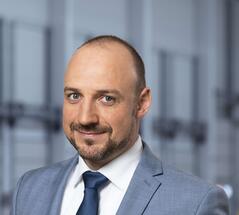As part of these changes, Martin Baláž, who was previously head of the subsidiaries in the Czech Republic, Slovakia and Hungary and Senior Vice President, has been appointed to his new position to increase the value of the company's portfolio in these countries rom now on also in Poland. This was the occasion for our interview, but we talked about much more interesting things than organisational changes.
- What does it mean in practice to streamline management structures, to separate the operational and capital investment functions?
- Organizationally, the creation of a new Head of Asset Management Central Europe is a core part of our practical steps to streamline management structures. For customers, this means a more hands-on, structured approach. The regional Heads of Asset Management, including myself, are responsible for overseeing all facets of Operations, Real Estate Customer Experience, Leasing, Facility Management and Operations Construction Management for each region. This change responds to the ever-greater need to maximize value from our existing assets. We own and operate nearly 5 million square meters of logistics real estate across Central Europe; with such a large footprint, it’s vital for us to have a unified contact point for Operations. Ultimately, our aim is to create even better experiences for the customers using these spaces; streamlined management will allow more effective decision-making in response to customer needs.
- What are the most striking differences between the industrial real estate markets in the three countries you monitor?
- Central Europe is a heterogenous bloc when it comes to the industrial real estate market. In Hungary, you have lower occupancy rates than in the Czech Republic and Slovakia, for example, and our operational priorities have to be adjusted in accordance with these differing realities. The Polish industrial real estate market has not seen such rapid rental growth as the Czech Republic, while Slovakia’s rent levels are relatively stable, despite seeing some stable moderate growth. These features of the market are constantly evolving and shifting. Then, you have differences in the regulatory environments governing each country. Extremely long approval processes are characteristic of the Czech and Slovak real estate markets, while such processes are more efficient in Poland and Hungary. For a developer, it’s impossible to say that one market is better than the other; each has its own characteristics and offers its own benefits.
- Your last press release states that the role of Built-To-Suit developments is growing. Does this also mean that the market is expanding or is it more a case of restructuring?
- A bit of both. Build-To-Suit developments are growing in popularity and importance because they ensure mutual benefits for the customer and the developer. Companies increasingly tend to prefer BTS developments, because such spaces better reflect their specific operational needs. BTS developments are tailored to facilitate their particular warehousing operations; we design such spaces in collaboration with customers and implement unique solutions based on their requirements. At the same time, BTS developments provide enhanced security for us, as developers of logistics real estate. Built specifically for a customer based on mutual agreement, they allow us to develop further without risking the creation of unoccupied premises, which would be disadvantageous for our business.
- What are the main trends in your opinion?
- The logistics real estate market is undergoing a period of stabilization, which was to be expected after the turbulence of recent years. A small correction of rent levels is taking place across Central Europe; after years of rapid growth, rents won’t increase as quickly as before. Yet simultaneously, from a technological perspective, we’re seeing greater innovation and ambition in the implementation of new technologies. This includes an increased focus on sustainable and zero-carbon energy solutions. As a market leader, we’re pioneers in this trend, aiming to achieve net-zero emissions from our operations by 2030, and net-zero across our entire value chain by 2040. Next year, we’ll achieve carbon-neutrality in our construction processes and 1 gigawatt of solar generation capacity worldwide. Another ambitious milestone is to have all our new developments carbon-neutral by the end of 2025. We’re also pioneers in implementing new solutions for our customers, including powerful automated processes that significantly enhance their operational efficiency. Our Prologis Essentials platform is a key part of this processes, providing a marketplace enabling customers to quickly and easily equip their warehouse spaces with everything they need. Trends such as a greater focus on clean energy and emphasis on the implementation of advanced technology make this a very exciting time for the industry throughout Central Europe.
- The warehouse market has performed very well in recent years, but how much room do you think there is for improvement in the sector?
- As one of the leading players on the warehouse market in Central Europe, we see significant room for improvement, and we’re always looking to bring more and more benefits to our customers. The shift in our management structure, with the creation of new regional Heads of Asset Management, is inspired by this recognition that there’s still so much more we can do for our customers.As a company, we focus on providing value beyond real estate. This is what underpins everything we do, whether it’s creating a stunning BTS space designed according to a customers’ needs, providing solutions such as Prologis Essentials that make us the perfect partner for customers, or recognizing that we have a responsibility to local communities in making our parks great places to work. Our success in recent years has been down to our ability to recognize the potential for logistics real estate to deliver something more than just great warehouse spaces. We’re going to continue in this vein, putting our expertise at the disposal of customers to constantly improve their experiences.
- What are your plans for 2024?
- In every market, we have key locations which we are keen to further develop and improve. These key locations aren’t necessarily the biggest, but due to prevailing factors in the market, they’re strategically important at this moment in time. In 2024, we want to further develop these important and exciting locations throughout Central Europe, in order to bring their full benefits to customers.
Raktarkereso.info



